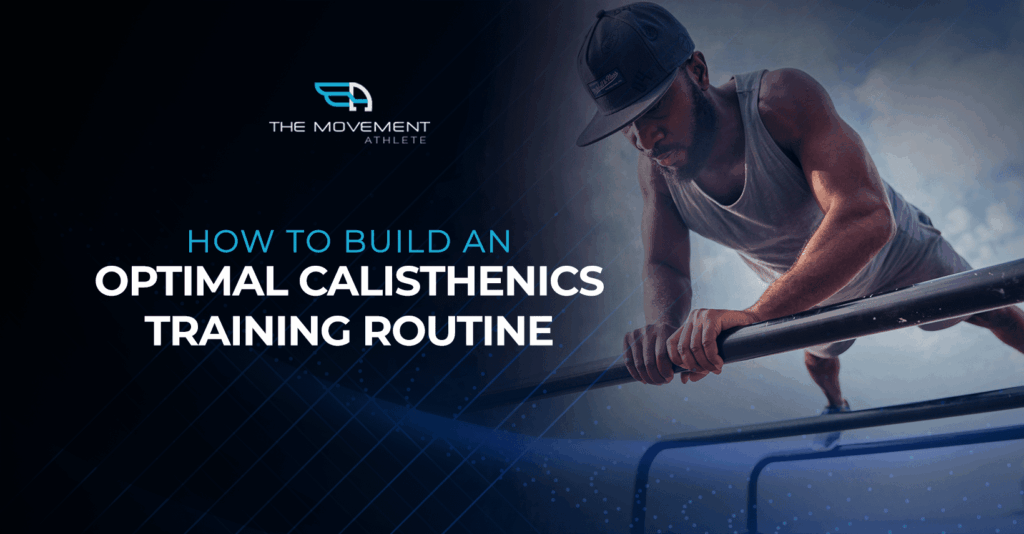

Join the tribe of Movement & Calisthenics Athletes – people just like you that are working with their own body weight to get strength, lose fat build muscle, recover from injuries and live their best lives!
Time is gold, ⏳ so you would only want to get the most out of your training when you work out. Although hard work does pay off, it’s always better to work smarter than harder. You can only do this with an optimal calisthenics training routine.
By optimizing your training routine, you achieve your goals faster and more efficiently while minimizing injury risks.
📌Not only that, an optimal routine keeps you motivated in the long run. It helps you stay consistent, too. As you should have known by now, you can achieve results through consistent and smart effort.
Let’s talk about step-by-step building an optimal calisthenics training routine to catapult your progress, making your goals your reality.
Not all programs are equal. We’re also going to cover the six vital elements of a successful training routine.
2 KEY POINTS BEFORE STARTING👊
But first, let’s discuss the three essential matters that need full attention before thinking about your routine.
These two points cultivate the starting point of your calisthenics and fitness journey. It is crucial to building them right from the start so you can already optimize your journey even if you haven’t started to work out yet.
It all starts in our minds.
1. ✅ Goal Setting
As evident it may seem, you first need to know why you need to work out. Set a specific, realistic and measurable goal in your fitness journey so that you won’t get lost on your goals.
Setting a goal also keeps you motivated on your workout to stay consistent and get the gains you have always wanted.
It can be from:
- 📌 Building muscle and strength
- 📌 Losing fat
- 📌 Increasing mobility on certain joints of your body
- 📌 Learning a specific calisthenics skill such as a handstand
- 📌 or any other goal you may think of.
Know why you want to train.
2. ✅ Setting realistic mindset
Upon setting your goals, you then need to realize the importance of having a realistic mindset.
I know you want those washboard abs and bulging biceps soon, but you won’t get it with a 2-week abs program you watched on Youtube. Nor if you ever get these goals immediately, it will be the end of your fitness journey.
It’s essential to keep in mind that fitness and health is a lifetime journey. There are tons of things to work on, and we can always improve an aspect.
When you instill this in your system, you won’t lose your motivation in your workout.
Once you have nailed this down and set in your mind that you have dedicated to investing towards a healthy body, let’s cover the elements of an optimal calisthenics training routine.
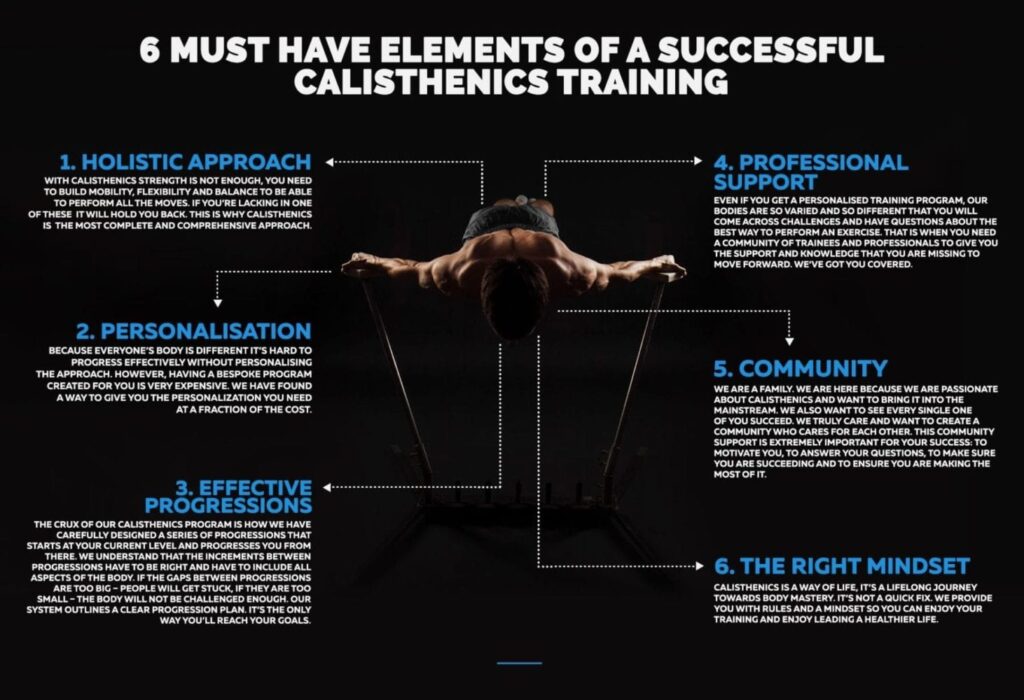
6 MUST HAVE ELEMENTS OF AN OPTIMAL & SUCCESSFUL CALISTHENICS TRAINING 🤸♂️
Before we make our way towards building a program, it’s crucial to know the optimal workout routine’s elements and characteristics.
Having these elements covered and refined, you’ll know that the training program is optimal for building a successful path towards your goal.
1. ✊ Hollistic Approach
While building strength and muscle is exciting, other fitness aspects such as mobility, endurance, flexibility, balance, and such should never get dismissed. Lacking in either just one of the attributes could hinder you from reaching your maximum potential or can even be detrimental to your progress.
Calisthenics is a top choice for an overall-balanced body. It’s naturally holistic as an approach and covers all the other aspects you need to have a complete body. It mostly consists of compound movements, while “isolation” calisthenics exercises still tend to be multi-jointed.
2. ✊ Personalisation
Cookie-cutter or beginner/intermediate/advanced aren’t going to cut it. They can hurt your gains!
With those types of programs, it’s either too undemanding that you’re not making any progress; or too challenging that you can either injure yourself or burn out. It may not even fit your hectic schedule!
Regardless, the result is demotivation, frustration, and could you quitting your fitness journey.
To counter this, choose a bespoke program that can provide you with enough stimulation according to your skill level, lifestyle, and goals. A fitting program keeps you progressing, motivated, and getting the results you’ve always wanted in an efficient, effective, and safe way.
3. ✊ Effective Progressions
A common myth about calisthenics is that you need to ramp up your reps and sets to get stronger.
That’s not the case, guys.
To progress, you need to follow a structured series of progressions that starts from your current level to get you where you want to be. No need to get stuck on skill level as you can always move forward to more challenging and harder progressions.
Plus, you’ll enjoy more exercises that keep you challenged—no more boring 100 reps for five sets that will not get you stronger.
It’s even in its name: progressions are the key for you to progress.
4. ✊ Professional Support
No matter how good your program is, you’ll always need some kind of assistance, and seeking professional advice will still boost your results in terms of quality and efficiency.
Knowledge expansion also plays a vital role in keeping you moving forward in your overall fitness and health.
If you can get access to credible sources of support, take advantage of that opportunity!
5. ✊ Community
We, human beings, are social creatures. Of course, there are times that we want to be alone, but most of the time, we want to be with our families and like-minded people.
The same thing goes when you train. It’s best when you have someone around you to keep you motivated and push each other to train harder.
Everybody needs support in some way. Joining a calisthenics community or talking/training with family or friends will help you sustain your training routine.
6. ✊ The Right Mindset
The right mindset launches you towards your goals in the long-run and keeps you in your path. It’s not just about having a plan. Mental preparation is as equally important as physical preparation.
Remember that calisthenics is a way of life. It’s a lifelong journey towards body mastery. There are no quick fixes, and setting long-term goals is a must.
The right mindset will also keep you motivated, so you won’t get frustrated when reality hits you. There’s no way to learn planche in 2 weeks (unless maybe you’re a monster). There’s no way to lose 150lbs of fat in 7 days.🤥
Just enjoy the journey, be consistent, and you’ll get there soon without you realizing that you’re already there.
Now that you know what an optimal routine and program should look like, let’s continue building a program plan for you.
🔎How to Structure a Calisthenics Workout?
Follow these steps to build AN OPTIMAL CALISTHENICS TRAINING ROUTINE
STEP 1: How much time do you have? ✔️
We’ve talked about the three key points earlier. By now, you should have set your mind in the right direction and know why you want to train.
The first step now is evaluating how much you can commit to achieving your fitness goals.
Every one of us has tons of commitment inside and outside our personal lives. Evaluate your time and determine how much you can dedicate to your training.
Don’t go overboard and allot your whole day for training if you’re not a professional athlete competing at an elite level. Be realistic.
You can set 90 minutes of your time of the day as the maximum duration. Warm-ups, primary workout proper, and cool down here are included.
If life gets in the way and you can just dedicate 15 minutes of your time. That’s enough as well but consider the results you will be experiencing.
At least give a minimum of 30 minutes of your time, even divided into two parts of your day, to get a more comprehensive workout plan.
STEP 2: What exercises should be in your calisthenics routine? ✔️
The next step is to know what exercises to use.
There are tons of exercises, and it also depends on your goals.
As a general rule, consider building an excellent foundational strength by training the fundamental moves in calisthenics.
At The Movement Athlete, we follow these nine fundamentals to build a good general strength foundation. These fundamentals hit specific body parts and teach our body the essential coordination that later prepares us for more advanced movement patterns.
Start with 9 Fundamentals 💪
Back trains the lower back, which is also part of your core.
Push-up covers the horizontal pushing strength, building strength and muscle for the chest, shoulders, and triceps.
Dips is the vertical pushing counterpart of push-ups that targets the same muscle group but focuses on the different movement pattern.
Pull-up is for the pull strength that targets the back, biceps and excellent emphasis on the core. Although this is a vertical pulling exercise, it’s foundation starts with horizontal pulling movements.
Squats emphasize the lower body strength as well as the lower body joint mobility.
Handstand is a necessary and basic calisthenics skill. It builds shoulder, straight-arm, wrist, and core strength while teaching basic posture for advanced calisthenics skills.
Body line training strengthens the core in the anti-extension position, which is mandatory for many calisthenics exercises.
Abs training is favorite for many. Take note that training your abs does not guarantee a visible 6-pack. It all boils down to nutrition, but ab training is excellent for core development.
Sides emphasize your obliques, the sides of your core.
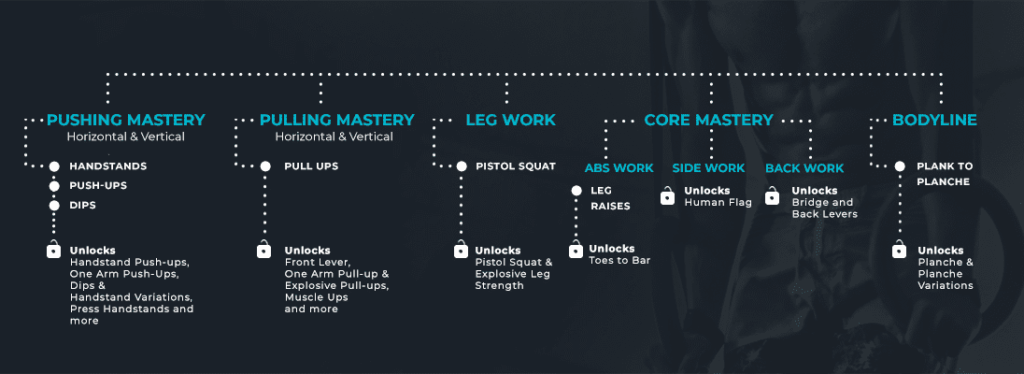
Dedicating your attention to these fundamentals assures you holistic growth with calisthenics.
STEP 3: What progressions to use in your own calisthenics workout?✔️
For each of these body parts there are specifc progressions that will take you from zero to advanced movements.
It’s REALLY IMPORTANT THAT YOU GO THROUGH THE PROGRESSION AND DECIDE WHICH STEP ARE YOU AT.
To do that we strongly suggest that you take this free ASSESSMENT That we created that will tell you exactly where you are at all these fundamental progressions:
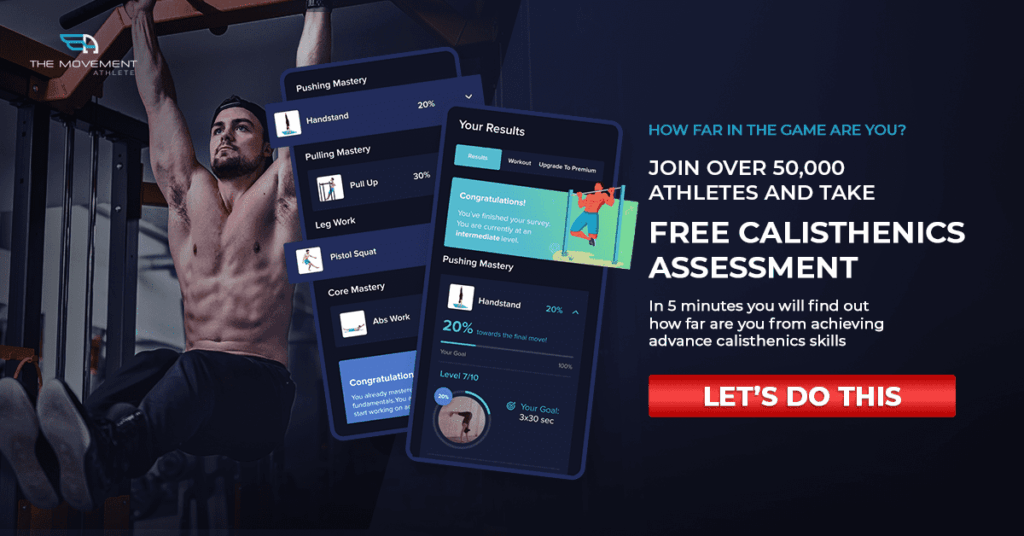
You can easily adjust the exercise intensity by changing each exercise’s amount of weight in weight training.
In calisthenics, progressions are the key to adjust exercise intensity. Progressions are variations of a fundamental movement pattern. They are arranged with increasing difficulty and adjusted by manipulating the body leverage.
After choosing your exercises, choose the right progression for each exercise that corresponds to your current skill level.
You can check out our free assessment in the link below so you can have a gauge of what you can work with.
The Movement Athlete Free Assessment
STEP 4: How many reps and sets should you use in your calisthenics workout✔️
Let’s talk about volume or how much work you need to do to make progress.
When talking about volume, we’re pertaining to the reps and sets of each exercise.
Repetitions or “reps” are the number of times you repeated an exercise in a row.
Sets are the number of reps done in-between rest periods.
You can keep in mind this general guideline on reps and sets.
1 – 6 reps – Strength development
8 – 12 reps – Muscle building
12 + reps – Muscle endurance
For sets, you can set around 3 – 5 sets in total.
Keep in mind that you need to choose the appropriate intensity for exercise to optimize your gains. If regular push-ups are too easy for you, but you’re still following the strength rep range, you won’t gain any strength.
Choose the right progression that allows you to achieve the rep range while keeping the movement challenging.
For beginners, you can start an easy exercise with a higher number of reps and sets. Just get a feel for the movement, so your body can adapt to the new stimulus.
STEP 5: How long the rest periods be?✔️
Like the previous step, there’s a recommended general guideline for setting rest periods. It depends on the goal of the specific exercise.
Strength Development – 3 to 5 minutes.
Muscle Building – 1 to 2 minutes
Muscle Endurance – Just enough so you can move to the next set.
STEP 6: How long should your calisthenics workout be? ✔️
Ideally, you would want to get at least 30 minutes of workout to cover the full body and achieve a fair amount of workout volume.
If you can, you can go as long as 90 minutes with warm-up and cooldown exercises included.
But if you’re too busy and just try to move with any amount of time you can.
Remember that the best exercise is something you can do consistently.
STEP 7: How many days per week of training should I do?✔️
For those who are just starting, train full-body with three workouts per week. This format allows a fair amount of recovery time for each workout session while providing enough growth and development stimulus.
You can opt to train for more advanced individuals for 4 to 6 days a week, preferably with a split workout routine. Just be sure to adjust your intensity and always allow one full day for recovery. This goes the same for skill training, which requires a higher frequency.
Keep in mind that your body gets stronger during rest and not during the workout itself!
STEP 8: How to record my progress ✔️
The best way to stay optimized with your routine is to have a detailed recording of your workouts and progress.
Tracking your progress allows you to see the results that might not yet be visible visually. It also gives you an overview of your journey, so you’ll know if you have any weak points that need addressing.
It’s easy to track. You can do it old school and track your training with a notebook and pen.
Or you can also use your mobile device or laptop with an Excel file, Word file, or even as simple as notes.
Just follow a simple format:
- Write the date, exercises, exercise intensity, reps and sets, duration of rest, and tempo.
- Add specific notes, such as if you’re struggling in a particular exercise but make it as measurable or specific as possible.
- Continue this for other dates and keep adding reps, sets, decreasing rest periods, increasing time under tension, or increasing intensity.
- Reap your rewards.
Handstand PROGRESSION Workout EXAMPLE
So taking everything we learnt so far we will take an example of Handstand Progression and show you how would you determine your lever and exercise to use.
Remember that learning a handstand is still a challenging task even if you’re already a generally strong athlete. There are muscle, strength and skill requirements involved where you can also read in our other article: From zero to upside down step by step. The most effective handstand progression. Add that there’s also a great deal of focus and mental sharpness needed in attaining a consistent free-standing balance.
🎯Below we want to show you
1. 👊What are the elements of a successful handstand workout
2. 👊Show you an example of a 45-min sample workout (beginner, intermediate & advanced) that you can do that’s focused on getting you your handstand.
🤔What makes an effective Handstand workout?
So the journey is one of the key concepts in TMA, but the real MAGIC HAPPENS DURING the WORKOUTS through its UNIQUE STRUCTURE.
Let me show you why.
Calisthenics is so powerful because it’s complex.💯
You might have enough strength to do a handstand but if your shoulder mobility is off you won’t be able to hold it.
Then there is a skill element. In the handstand example, the skill would be learning body alignment and entry and exit strategies.
Next is endurance which means improving your work capacity of being on the hands.
And then there is building muscle mass 💪 to support that mobility and ligament development
Programming for all these elements is difficult so 99% of the programs you will see our there will never even mention these different elements.
And this is something that we do very differently than everyone else on the market.
We structure your training program around these elements creating a holistic approach for all-round development.
So your daily calisthenics workout should be structured to include these elements:
Warmup + Mobility
Skill Work
Strength Work
Endurance Work
Muscle Building Work
Cooldown + Flexibility Work
It’s SO CRITICAL YET NO ONE IS TEACHING THIS
Ok, Let’s look at each one of those separately.
✨SKILL WORK
The technique is key in calisthenics. These movements are designed to either draw focus to specific technique cues or train important movement patterns for the subsequent strength movements. Skill movements are done at a low intensity and low total volume.
✨STRENGTH WORK
Strength movements or main movements are the reason we are here. These are the movements that will chart your progression through the world of calisthenics and bodyweight fitness. There is a large variation in strength movements, from easy to hard, low volume to medium/high volume, dynamic to static but the reps and sets are optimised for strength building
✨MUSCLE WORK
A bigger muscle has the potential to become a stronger muscle. Muscle movements are movements that are done at low-to-medium intensities and higher total volumes for the purpose of building muscle. The lower intensities also allow athletes to focus on the muscles involved and to get a good squeeze and pump. Many muscle movements are pulled from appropriate strength movements but have a different rep scheme to strength.
✨ENDURANCE WORK
Many calisthenics movements involve static holds. Endurance movements train the athletes’ capability to hold the body in various positions. These are typically programmed to be easier than the equivalent strength movement holds. Instead, more work volume is added for more practice time.
Taken together, these different movement types are designed to produce skilled, strong and complete bodyweight athletes.
And this is what you would be getting inside The Movement Athlete App
HANDSTAND WORKOUTS 🔥
Now, let me just say that at The Movement Athlete Academy we are really against creating cookie-cutter workouts that limit you to beginner, intermediate advanced.
There is a scientific research showing that not only the risk of getting injured is much higher if you follow ready made routines – the risk of you not making any progress is way higher too.
You can read more on this here: Death to beginner, intermediate, advanced workouts that are hurting your training
Hence, the workouts that are shown below are there as an example of workouts that you will see inside our app.
Yes you can use them and follow them – but we really advice that you follow a more personalised training.
You can asses yourself which progression are you currently on by following our handstand progression here 👇
HOW TO CREATE THE MOST EFFECTIVE HANDSTAND WORKOUT FOR YOUR LEVEL?
Here are the steps to follow if you would like to create your own personalised workout.
1. Assessment
Look at the strength progression. Your goal is to pick the exercises in teh strength progression that you can do at the mastery level
2. Match the strength exercises with Skill, Muscle and Endurance
exercises that are on the same line. This exercises is what when achieved will enable you to level up.
3. Put it into a workout with given programming
Below are example of workouts that are created based on where are you in the progression – either in early stages (we called in a beginner), middle stages (intermediate) or advanced (closer to the end of the progression.
👉Beginners 45-Minute sample workout
As a beginner learning a handstand, you would want to learn your handstand while achieving an overall good baseline of strength, mobility, and endurance.
This would allow you to progress faster, see faster results, make the process more enjoyable and will keep you motivated to train your handstand overtime.
Also do remember, even if you’re trying to learn a handstand, it’s better to set a larger and long time goal. Long time goals keep you motivated and will help you more disciplined in your training.
Don’t give up!
Regarding your beginner handstand workout, more basic progressions are used and exercises are aimed to develop overall strength.
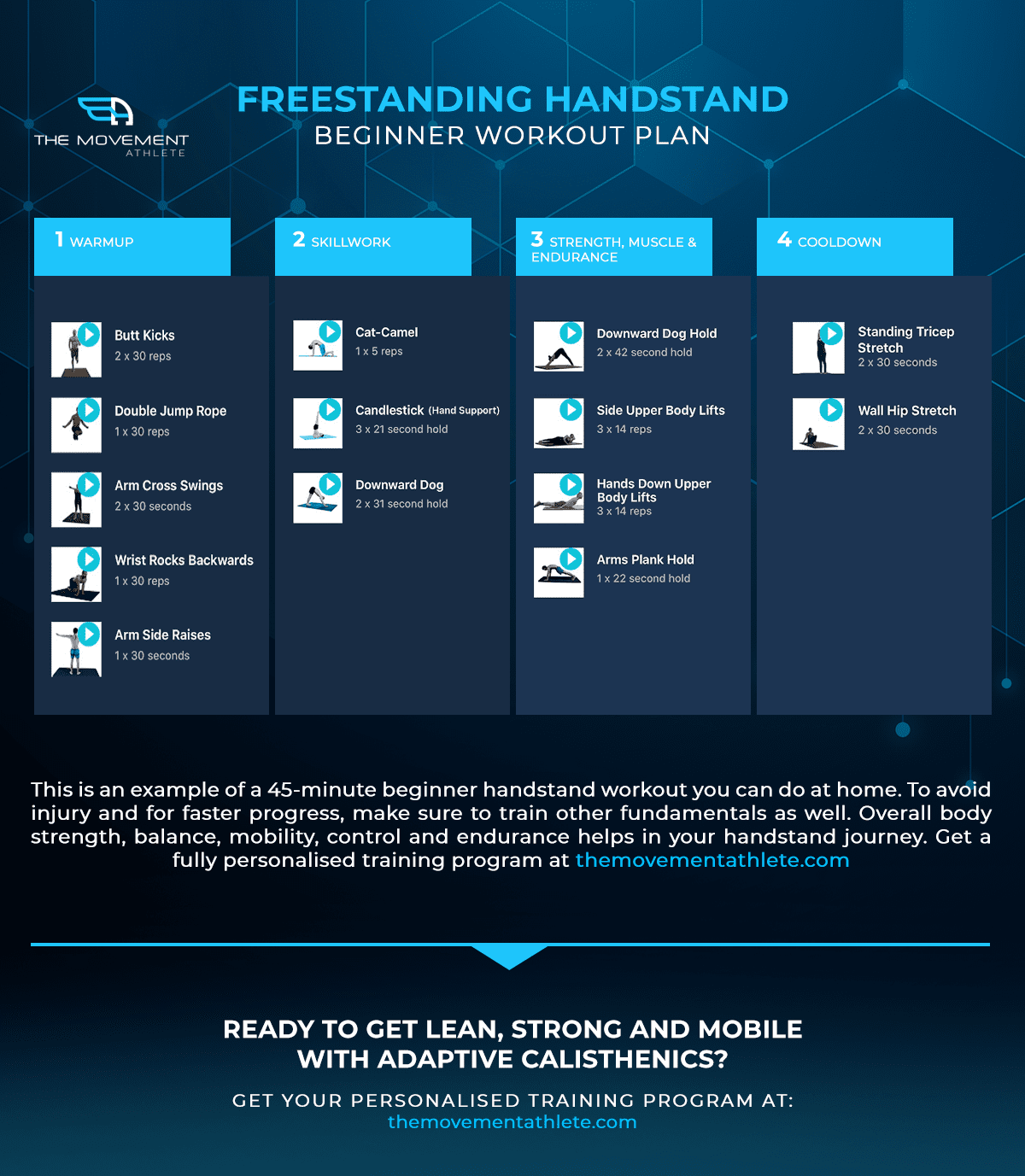
👉Intermediate 45-Minute sample workout
For more skilled athletes, we’ll be providing you more advanced exercises.
You’ll also be preparing more shoulder strength and core since they will be the major muscle groups working to get you to hold a free-standing handstand.
Strengthening exercises are not solely for strength as they will also help you increase your mobility mainly on your shoulders. Shoulder mobility is one of the main problem areas that hinder people from learning a good form of a handstand.
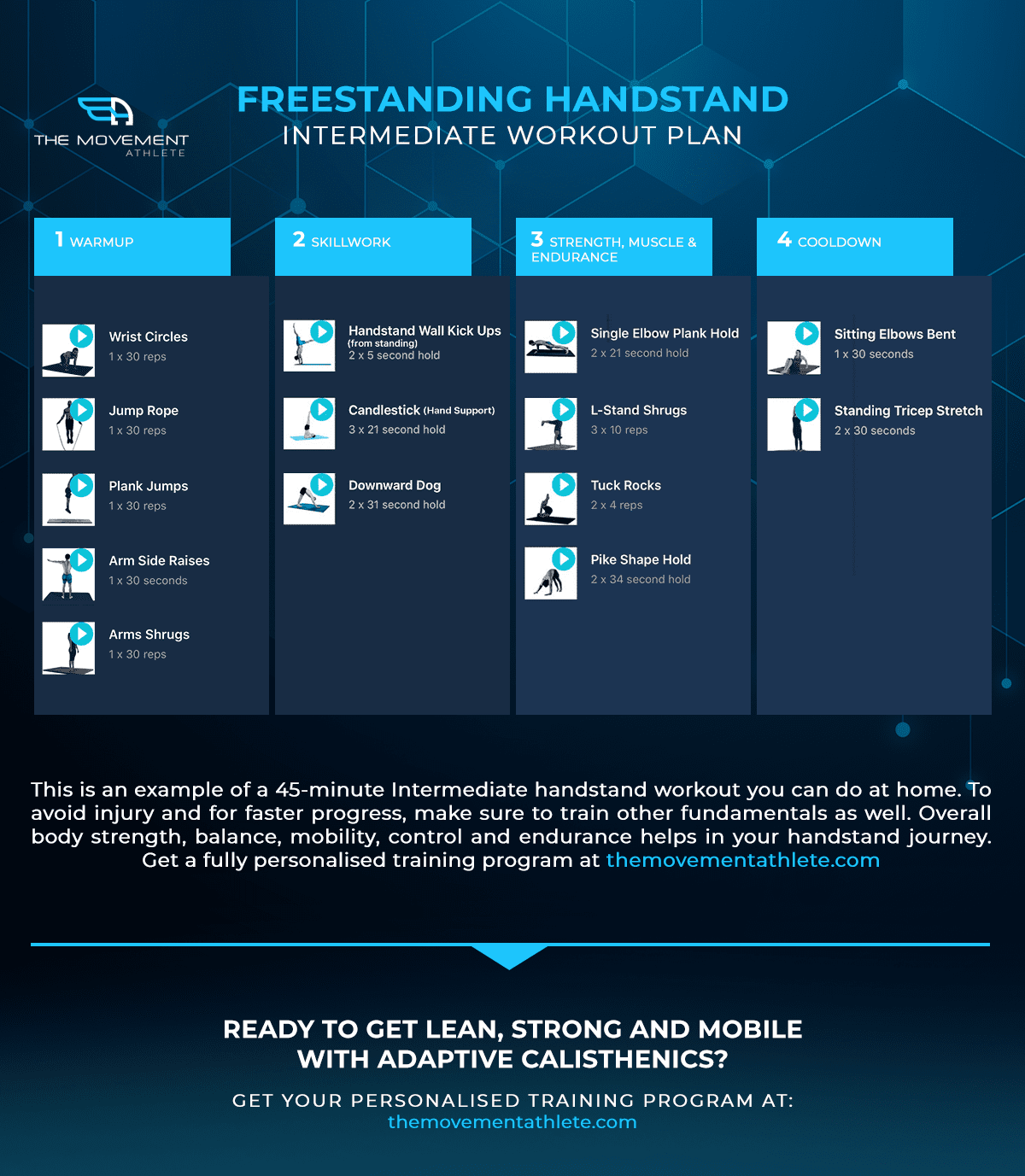
👉Advanced 45-Minute sample workout
If you’re already an advanced athlete, you are expected to already have a good level of core and shoulder strength. Well, your whole body should already be strong and well-balanced at this point.
So the focus of your workout will be on strengthening key areas and common weak links in a handstand.
Common weak links mostly include shoulder mobility issues that hinders you from opening your shoulders. Open shoulders let you stack your full body in a straight line.
Lying shrugs is a good example. Don’t underestimate this exercise. It looks so easy, but if done correctly, it’s still a humbling exercise.
Core strength is another area that needs to be addressed.
No, sit-ups won’t help you that much. Handstand needs a transferable strengthening exercise that mimics the position when you are in a handstand. A good example of this is a hollow body hold.
Train your weak links and you will soon hold your handstand.
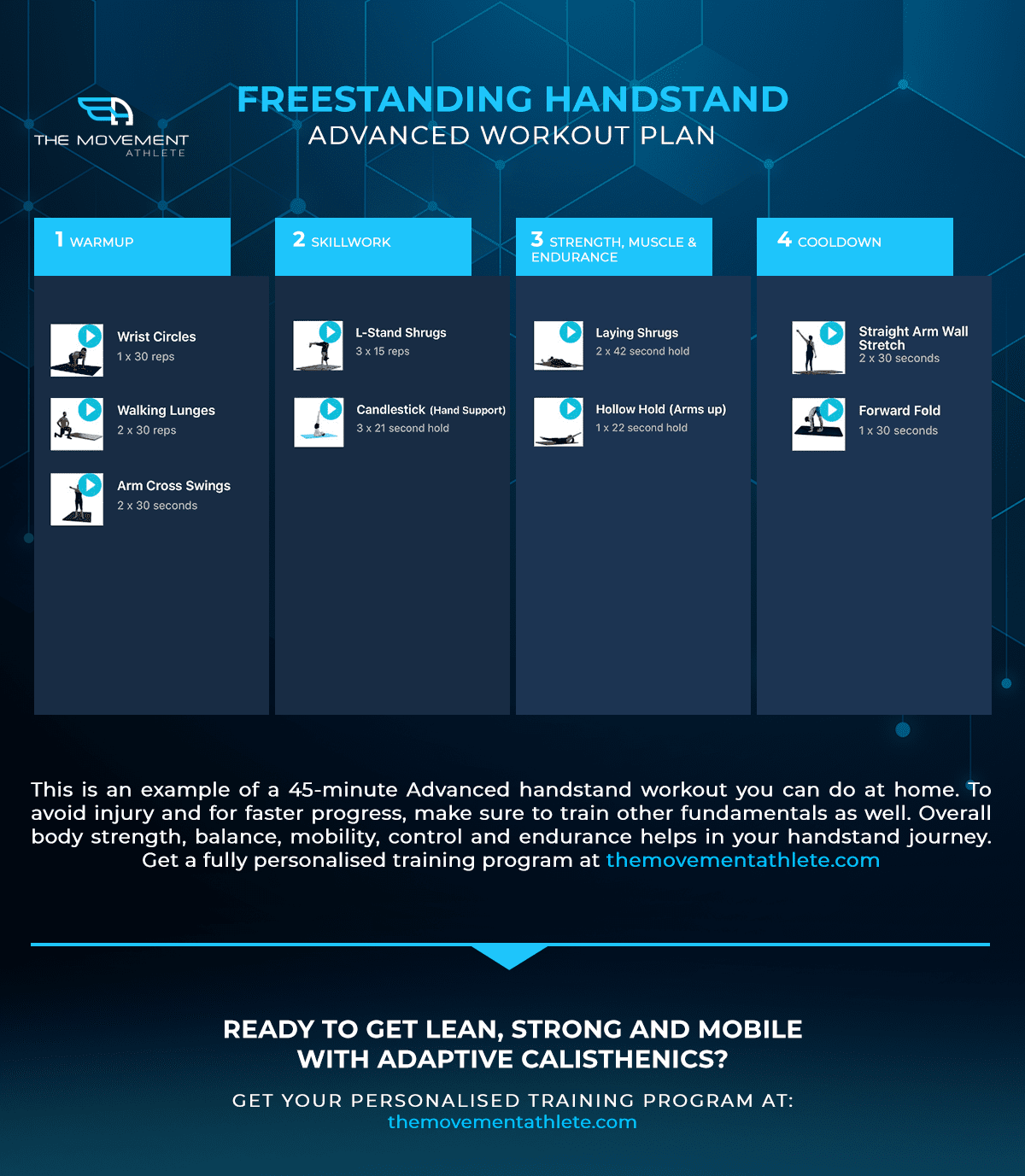
🔎Ready-made workouts are not the best
Just before you jump straight into this workout and expect some gains, you need to know that these types of workouts are not ideal to progress in calisthenics.
At first glance, the workouts seem promising. It’s divided into levels in which you can categorize yourself into.
But these questions and realizations will come into mind especially once you got to try the actual workout:
- ✊ How can you really tell if you’re already an intermediate, advanced athlete or still a beginner?
- ✊ The difference in difficulty from each level is too drastic.
- ✊ Some exercises are too easy or too difficult for you.
- ✊ There are lagging body parts that I need to address.
- ✊ The whole workout makes me progress too fast or too slow.
With these realizations in mind, you might end up demotivated, uninspired and ultimately quit your training.
Such training programs also post a higher risk of injuries due to the sudden jumps of difficulty and inability to address weaknesses.
Powered by a powerful Artificial Intelligence, The Movement Athlete Academy app creates a program that is perfect just for you.
Personalized workouts are the exact opposite of the ready-made workouts.
First, since personalization is specific to your needs, goals and current situation, an assessment will start your program. The assessment bases the structure of your program so you’ll have the right level exactly just for you in every aspect.
Your new program isn’t set in stone. As it’s fully personalized, it will continue to adjust based on your current progress and ability to train that day.
Let’s be realistic. There are just those days that we can’t perform like we want to because of other factors in our lives affecting our performance. The Movement Athlete app adjusts for you.
If you badly want to reach your handstand, train realistically.
Train safely, effectively, efficiently and with purpose. All of these while keeping it fun.
If you want to learn handstand, train with The Movement Athlete.
Following these steps helps you optimize your calisthenics training routine. There are a lot of factors and details you need to think about. It sounds complicated. It can even be overwhelming, especially for beginners.
But what if I told you that there’s a way to optimize your calisthenics journey without having to think about these factors and steps?
🤔How to skip YEARS of frustration and start seeing results with
OPTIMIZED structure of a calisthenics workout
☝️Learning Calisthenics on your own is frustrating and confusing, especially if you want to optimize your training routine so you’ll get the most out of your workout. As we have covered already earlier, you have seen the factors you need to consider when optimizing your program.
We often hear stories of athletes putting in a lot of effort and still NOT getting their desired results.
There are tons of individuals quitting calisthenics or fitness in general because of lack of progress or even burnouts. Their frustration leads to the demise of their fitness journey and health.
You don’t have to worry about these types of obstacles you might encounter when training with calisthenics because we’ve got you covered!💪
🤜WITH THE MOVEMENT ATHLETE, YOU CAN OPTIMIZE YOUR TRAINING AND MAKE PROGRESS 🏆EVERY SESSION
What sorcery is this you, you might ask?
No magic nor fantasy here. Just pure science and math to create a specific workout routine just for you.
Here are the ways how The Movement Athlete structures a calisthenics workout:
1. ⚡️Whole-body fitness through Algorithmically Optimized Split Routines
Yes, a holistic approach with split or full-body routines allowing you to get challenged and stimulated while allowing proper rest periods for recovery and growth.
I have to emphasize that this is 👉 PERSONALIZED and TAILORED for your skill level and goals that fit your lifestyle.
Now you don’t have a reason to postpone your training because you’re “busy.”
The Movement Athlete provides a structured, effective program that fits your skill level and lifestyle so you can train even for 15mins a day🎯 and make good progress.
2. ⚡️Progression, Regression & Back up drills
Speaking of progress, you can achieve this by a clear and optimized series of progressions for every exercise possible.
👍No exercise is too strenuous or too easy as all can be adjusted for your specific skill level. Add that you’ll never get bored as you’ll never run out of new, fun, and efficient exercises to do!
These exercises are not random. These are tested & optimized progressions selected by a group of high-level calisthenics athletes, gymnastics, and physiotherapists, so you’ll know you are in the right hands of a set of professionals, not just from any individual.
3. ⚡️Auto-regulation
Speaking of progressions, you get to know which progression to use with the right amount of volume since The Movement Athlete app follows a structured program with AUTO-REGULATION.
To summarize the concept, the powerful artificial intelligence that helps generate The Movement Athlete workouts adjusts to your current performance and ability to do work.👈
No matter how consistent we are or strong💪 we are, there will be days that we cannot perform how we performed yesterday or the other day.
That’s just how our body works. Life is unpredictable, and our energy could be depleted in some days and restored in others.
With auto-regulation in training, the program you get adjusts to let you perform in your current state. It keeps the workout enjoyable while challenging enough to keep you improving.
👉You can read more on Auto-regulation in this article → Secret Weapon — Auto-regulation
TO SUMMARIZE:
Optimizing our training brings nothing but benefits. We all want to get the most out of what we invest in.
So keep in mind the six elements you need to include to keep your calisthenics training optimized:
- ✊🏻 Focus on a holistic approach
- ✊🏻 Keep your training program personalized.
- ✊🏻 Look for effective progressions.
- ✊🏻 Seek professional help
- ✊🏻 Join a supportive community or group
- ✊🏻 Have the right mindset
Here are the steps that you can take to build an optimal calisthenics training routine:
- 📌 Know how much time you can invest.
- 📌 Learn what exercises you can use.
- 📌 Identify the progressions you should use.
- 📌 Determine the number of reps and sets.
- 📌 Learn how much rest you need to take each exercise.
- 📌 Learn how long each workout should take.
- 📌 Identify how many days per week to train.
- 📌 And master how to record and track your training journey.
All of these steps, when done correctly, will lead you to an optimal training routine, but you don’t need to bother yourself learning all of this if you have The Movement Athlete guiding you in your fitness journey.
And when you have optimized your calisthenics training with a routine with The Movement Athlete, you’ll get to enjoy these LIFE-CHANGING BENEFITS:
- 🏆 Gain Muscle and Lose Fat Simultaneously
- 🏆 Transform your Body
- 🏆 Freedom to Train Anytime and Any Place
- 🏆 Help Prevent & Recover from Injuries
- 🏆 Strengthen Your Joints Naturally
- 🏆 Develop Amazing Skills
You can also listen to other Movement Athletes and know how TMA transformed their lives. These are real people, enjoying real results and real life-changing benefits from moving together with The Movement Athlete.🔐
If you want to enjoy these benefits as well, I dare you to optimize your training and BE A MOVEMENT ATHLETE! 💪💪💪